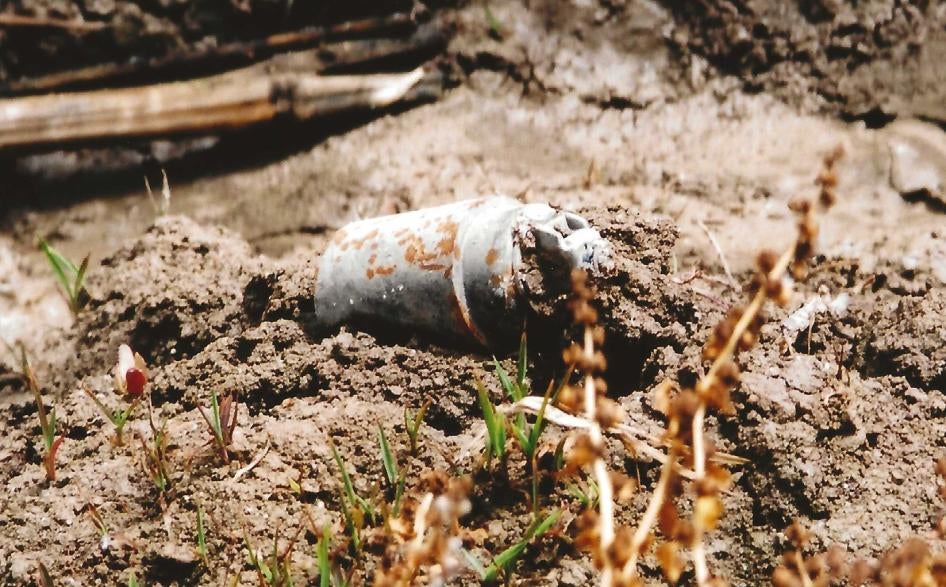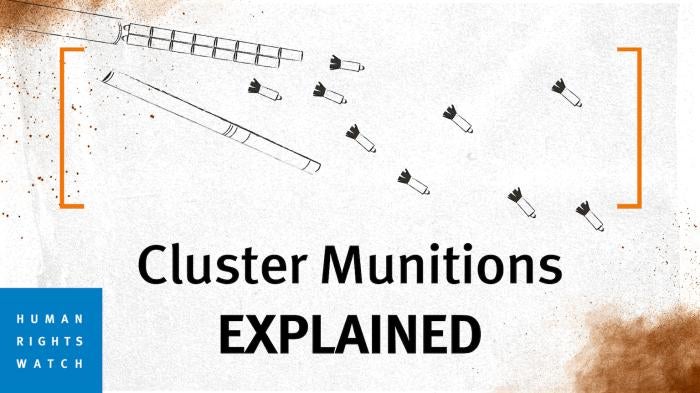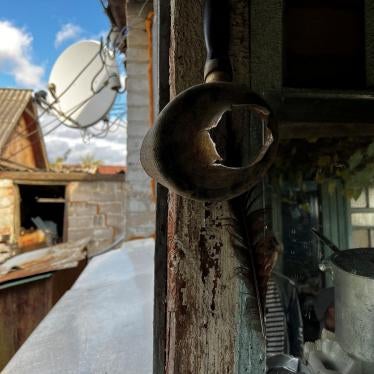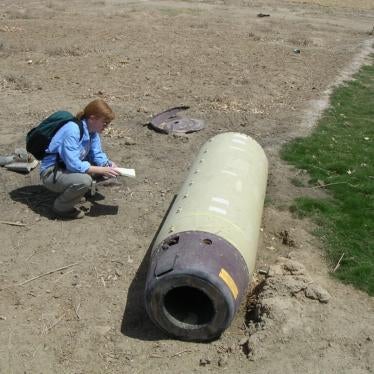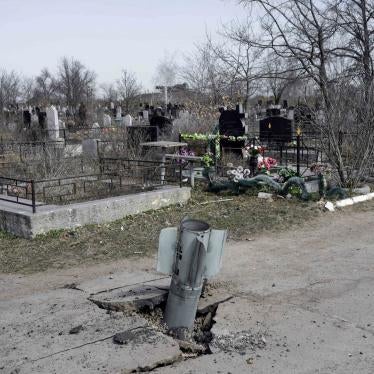President Joe Biden’s recent decision to transfer U.S. cluster munitions to Ukraine will exacerbate a humanitarian crisis and break with a widely followed international norm. The move encourages the proliferation of weapons that have been banned by over 120 countries because they endanger civilians both during strikes and for months, years, and even decades afterward. Having witnessed the gruesome impact of cluster munitions first-hand, I find the U.S. rationale for transferring them weak on multiple fronts.
Cluster munitions, which Russia has used extensively in Ukraine, disperse dozens or hundreds of smaller submunitions, or bomblets, across a broad area, the size of a city block. Each of these submunitions shatters into metal fragments that can tear off limbs and inflict fatal wounds. They cause civilian casualties at the time of attack because they cannot discriminate between soldiers and civilians. In addition, many do not explode on impact, lingering like landmines and posing an ongoing threat to the local population.
In news conferences on July 7, U.S. government officials justified the transfer of artillery projectiles containing cluster submunitions known as Dual Purpose Improved Conventional Munitions (DPICM) on several grounds. National Security Advisor Jake Sullivan and Undersecretary of Defense for Policy Colin Kahl contended that Ukraine already faces a massive challenge to clear unexploded ordnance, that technological and targeting safeguards will reduce risks, and that Ukraine needs more ammunition to defeat Russian forces.
These arguments, however, do not heed the lessons of earlier use of such submunitions by the U.S. and other countries that illuminate the dangers of deploying cluster munitions to the battlefield. Listening to White House and Pentagon spokespersons brought to mind interviews, images, and evidence from my field research with Human Rights Watch, which illustrate why this transfer is profoundly troubling.
Every Submunition Presents a Danger
While acknowledging that cluster munitions harm civilians, U.S. officials argued that using them will not significantly worsen the situation in Ukraine because the country already has to clear large numbers of Russian munitions, including submunitions and landmines. In addition, Ukraine has pledged to record where they use the weapons, and the U.S. has committed to support clearance efforts.
This reasoning ignores the threats to individual civilians waiting for their land to be cleared. Every unexploded submunition endangers a curious child, a farmer plowing a field, or a refugee returning home. The submunitions’ presence also slows reconstruction.
Children are the most common victims, as my Human Rights Watch colleagues and I found in Iraq in 2003. There, the U.S. widely used cluster munitions containing DPICM submunitions, including M42 and M46 submunitions for artillery projectiles, and M77 submunitions for rockets.
“Cluster bombs sometimes look like beautiful things,” a doctor at Iraq’s Najaf Teaching Hospital explained to us at the time. “Children like to play with them. [They] are here and there, everywhere on farmland.” Twelve-year-old Abbas Hussain, who was at that hospital, picked a submunition up on a road, thinking it was a toy, but it exploded and ripped off half of his hand.
DPICM submunitions are particularly attractive to children because they resemble a bell with a loop of ribbon at the end. “It’s nice for carrying,” one U.S. military officer told me in Baghdad, describing the threat to children. In Ditsi, Georgia, in October 2008, I interviewed Omar Mindiashvili, a displaced person who had recently returned home. He caught his 13-year-old daughter, Salome, swinging a Georgia-fired M85 submunition, which she had found on the roof of their porch, by its ribbon. Fortunately, he recognized the danger from a “risk education” TV advertisement and stopped her before it detonated.
Rami Ali Hassan Shebli was not as lucky. In October 2006, the 12-year-old boy picked up a strange object in a field near his village of Halta, in south Lebanon. Rami wanted something to toss back at his older brother Khodr, who was dropping pinecones on him from a tree. A bystander recognized the object as a submunition and yelled for Rami to drop it. The submunition exploded when Rami’s hand was behind his ear, killing him instantly. My team and I arrived as two men shoveled bloody dirt into a box and Lebanese Army deminers destroyed 15 unexploded DPICM submunitions, all left from an Israeli cluster munition attack in an adjacent field.
Cluster munitions can also impede or cause casualties among friendly forces. A British officer, Col. Gil Baldwin, described encountering a field of unexploded submunitions, launched by the U.S.-led coalition, just 500 meters after crossing the border from Kuwait into Iraq in 2003. “The first night [of the war],” he told me, “the lead vehicle of our convoy [drove] straight into a cluster bomb field. The corporal [who found the DPICM submunitions] came out white-faced…. It took half an hour to get out.”
Clearance is dangerous, time-consuming, and expensive. Doing it well involves highly trained professionals with specialized equipment carefully marking and examining land meter-by-meter. But environmental conditions, such as heavy rains or flooding, can frustrate even the most careful demining operations. Adding any number of submunitions to the contamination can slow clearance operations and exacerbate the danger for demining teams and for civilians who seek to return home. To make matters worse, residents often try to remove submunitions from their land or their homes themselves, which puts them at risk and complicates clearance for the professionals.
Insufficient Safeguards
U.S. officials also said that technological and targeting precautions would help mitigate the risks of using cluster munitions in Ukraine. They claimed the U.S. cluster munitions to be transferred will be safer than the Russian cluster munitions because they have a significantly lower dud rate, that is, the rate at which submunitions fail to explode. Without revealing the sources or methodologies for making such claims, on the grounds that they are classified, Kahl said that tests show that U.S. models have a less than 2.35 percent dud rate, compared with the Russians’ rates of about 30-40 percent. Ukrainian forces have used the same type as their Russian counterparts.
But technological fixes are rarely a panacea, and testing can be deceiving. Fifteen to 20 years ago, the M85 submunition was touted as the answer to the problems of cluster munitions because it had a self-destruct mechanism that reportedly lowered the dud rate to under 1 percent. Proponents argued that the technology would “sufficiently address humanitarian concerns.” Indeed, a British officer told me his troops were less careful about using M85 submunitions in populated areas because they believed the self-destruct mechanism would eliminate the humanitarian impact.
Field research proved that was not the case. My team documented M85 submunitions left by U.K. cluster munition attacks in Iraq in 2003. For example, when Mustafa Abd al-Hassan, a 45-year-old mechanic, returned to his home in Basra after the conflict, he discovered submunitions littering the neighborhood, with three in his yard alone. His experience was not unique.
A 2007 in-depth report, by C. King Associates, the Norwegian Defence Research Establishment, and Norwegian People’s Aid found that in combat conditions, notably in south Lebanon in 2006, the dud rate for the M85 was in fact 10 percent.
The researchers concluded that the M85 “illustrate[d] the substantial difference between results obtained during testing and the reality seen during operations…. Common testing regimes tend to produce very optimistic indications of performance; test results are therefore misleading as predictors of the actual risk to civilians.”
The researchers also found that the “discrepancy between testing and operational performance is greater for submunitions,” and DPICM submunitions in particular. The results persuaded countries negotiating the 2008 Convention on Cluster Munitions, which comprehensively bans the weapon, not to make an exception for submunitions with self-destruction devices.
The U.S. has also suggested that Ukraine’s assurances about where the cluster munitions will be used will address humanitarian concerns. According to Oleksii Reznikov, the Ukrainian minister of defense, “We will not be using cluster munitions in urban areas (cities) to avoid the risks for the civilian populations…. Cluster munitions will be used only in the fields where there is a concentration of [R]ussian military.”
While a positive step, better targeting, like better technology, is not a complete solution when it comes to cluster munitions. The minister’s statement refers to “urban areas (cities),” but what about other, smaller populated areas, such as villages and towns? If such areas are inhabited, residents would be at risk during strikes. If not, they could still be at risk years later.
Human Rights Watch has already documented how Ukraine’s use of cluster munitions from its own stockpile directly led to the death and injury of civilians in populated areas in and around Izium during efforts to dislodge Russian forces. Ukrainian officials have publicly denied these claims, and there is no indication that Ukrainian authorities have documented or investigated them.
The limited assurances provided by Ukraine are weaker than the instructions the U.S. gave to Saudi Arabia and other past recipients of U.S. cluster munition transfers: The receiving country must agree that the cluster munitions “will only be used against clearly defined military targets and will not be used where civilians are known to be present or in areas normally inhabited by civilians.”
In addition, by using cluster munitions against Russian troops, Ukraine will most likely contaminate its own agricultural areas critical to its economy. Returning farmers, like those from other conflict zones before them, will have to choose between risking their lives to till a contaminated field or losing their livelihood by waiting for the slow process of clearance. Given that Ukraine was a major exporter of grains before the war, especially to the Middle East, North Africa, and Europe, impediments to farming could also affect global food supplies.
A Dangerous Substitute
When announcing the transfer of cluster munitions, U.S. officials emphasized that the U.S. is shipping the weapons to Ukraine in large part because their ally needs artillery ammunition, and the U.S. doesn’t have any alternative artillery ammunition to offer at this point. Minimizing a failure to anticipate Ukrainian needs, officials repeatedly noted that the cluster munitions are intended to be a “bridge” while the U.S. “ramp[s] up” production of unitary artillery ammunition.
In Iraq in 2003, I similarly found that in some cases, U.S. Army officers said they used cluster munitions because they believed there were no adequate alternatives available. According to Third Infantry Division officers who spoke to me in Baghdad, the only long-range rocket artillery they had at hand was the multiple launch rocket system with submunitions so they used it for counter-battery fire even when a unitary weapon, if available, would have sufficed.
These officers and several others in Iraq recognized the threats cluster munitions posed to civilians and their own troops. The Third Infantry Division officers said they sometimes did not use cluster munitions even if they had the chance. Col. David Perkins said: “We had concerns about unexploded ordnance…. It’s a constant consideration. What are the second or third effects?” A Marine officer similarly told me that due to the unexploded ordnance left by cluster munitions, “We wouldn’t use cluster bombs in battle even if it degraded [our capacity].”
A Third Infantry Division lessons learned assessment also recognized the shortcomings of DPICM submunitions, describing them as “losers” and asking, “Is [the] DPICM munition a Cold War relic?” Yet 20 years later, the U.S. is transferring DPICM submunitions to one of its allies for a new conflict.
U.S. officials also argued that the cluster munitions being transferred to Ukraine will be useful for attacking Russian trenches and troop formations. But history shows that while cluster munitions are designed for use on against tanks and troops on isolated battlefields, in most conflicts, they end up being used in areas where civilians are located. Over the past two decades major use of cluster munitions has occurred in conflicts in Iraq, Lebanon, Georgia, Syria, Yemen, Azerbaijan, and Nagorno-Karabakh, each of which has featured attacks in populated area and caused egregious civilian harm.
Furthermore, whatever the military utility of cluster munitions, the weapons will cause foreseeable and irreparable civilian harm.
A Humanitarian Threat
The war in Ukraine has already provided ample evidence of the harm that cluster munitions can wreak on civilians. According to Human Rights Watch, Russia has widely used cluster munitions since its full-scale invasion in February 2022, causing hundreds of civilian casualties across 10 of Ukraine’s regions. An attack on a train station in Kramatorsk, for example, killed at least 58 civilians and injured more than 100, making it one of the single deadliest incidents of the invasion.
Human Rights Watch also documented the use of cluster munitions by Ukraine in and around the eastern city of Izium between March and September 2022. Those attacks killed at least eight civilians and wounded an additional 15, although the number of casualties is most likely much higher. An independent United Nations commission similarly reported evidence of civilian harm from Ukraine’s use of cluster munitions in Izium.
The Convention on Cluster Munitions was negotiated in response to the “unacceptable harm” inflicted by these weapons. Although the U.S., Ukraine, and Russia are not party, the Convention to date has 111 States parties and an additional 12 signatories. It prohibits the production, stockpiling, transfer, and use of cluster munitions, and assistance with those activities. It also obligates States parties to destroy stockpiles, clear unexploded submunitions, and assist victims.
A Strong Response
The decision to transfer cluster munitions is a disturbing change of course for the U.S. Since its widespread use of the weapons in 2003, the U.S. has only used cluster munitions once, for a single strike in Yemen in 2009. The last U.S. cluster munition manufacturer ceased production in 2016. Furthermore, President Biden had to waive a U.S. policy prohibiting transfers of cluster munitions with a more than one percent failure rate.
The transfer decision also runs counter to international progress, notably due to the adoption of the Convention on Cluster Munitions in 2008 and increasing stigmatization of cluster munitions it has generated.
Upholding their obligations under the convention, States parties have not transferred cluster munitions to Ukraine, even though many of them are its allies and have sent other arms. These States should ensure that they do not assist the U.S. with the transfer of its cluster munitions.
Following the U.S. announcement, more than 15 countries have spoken out against the use of cluster munitions, and some, including Cambodia and Laos, which are heavily contaminated by U.S.-delivered cluster munitions, have directly criticized the U.S. transfer. They have been joined by U.N. Secretary-General António Guterres and many civil society groups, including the Cluster Munition Coalition and Human Rights Watch. Such statements are critical to keeping the norm against cluster munitions strong.
Finally, rather than revert to the era when the U.S. last used cluster munitions, the U.S. and Ukraine, as well as Russia, should heed these calls. They should cease transfer and use of cluster munitions to protect civilians from an inhumane weapon and the mistakes of the past.

